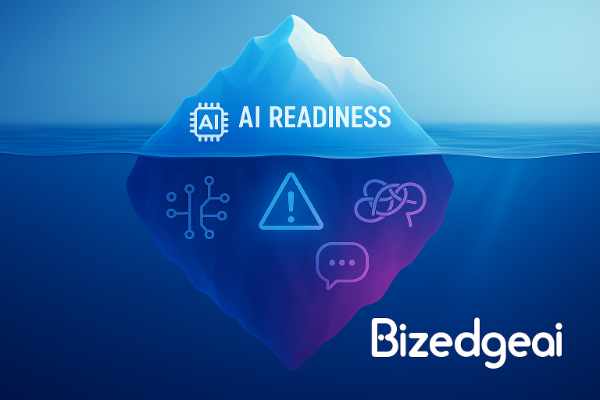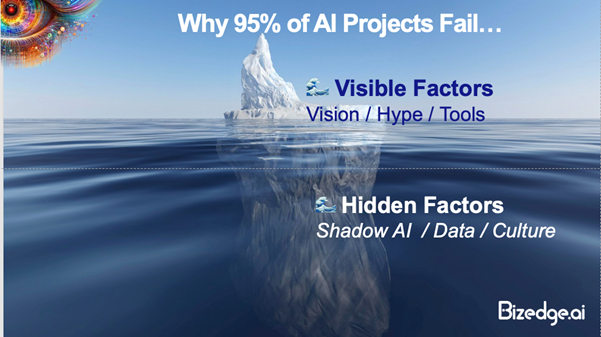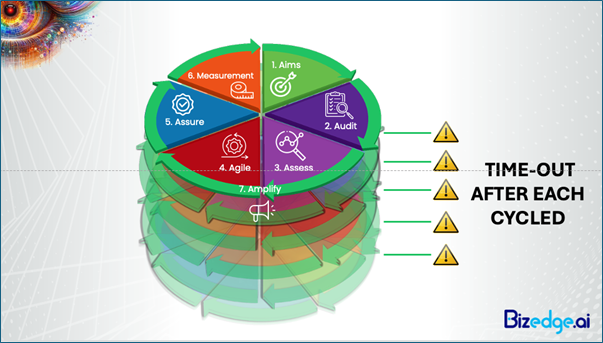Our Blog - Sharing & Informing

Are You Ready?
Understanding What Makes AI Projects Succeed or Fail
Two mid-sized manufacturing companies, both with around 150 employees, decided to embrace AI at roughly the same time. Both invested similar amounts. Both hired consultants. Both had ambitious plans.
Twelve months later, Company A had reduced operational costs by 18%, improved quality control, and freed up its management team to focus on growth. Company B had spent £50,000, created internal conflict, and quietly shelved their AI initiative, hoping no one would ask about it at the next board meeting.
What made the difference?
It wasn't the technology. Both companies used similar tools. It wasn't the budget. Both invested comparable amounts. The difference was deceptively simple: Company A asked "Are we ready?" before asking "What should we buy?"
As I discuss in my book, The AI Business Opportunity, readiness is the single most significant predictor of AI success. Yet most businesses skip this question entirely and jump straight to vendor demonstrations and proof-of-concept projects.
The 95% Failure Rate—And Why It Happens
Research from MIT reveals a sobering statistic: between 90% and 95% of AI projects fail to deliver their expected value. That's not a typo. Nineteen out of twenty AI initiatives underperform, stall, or collapse entirely.
Here's what's remarkable: the problem is rarely the technology itself. AI tools work. They're powerful, increasingly accessible, and becoming more affordable every month. So why do most projects fail?
The answer lies in what I call the "Iceberg of Confusion"—the hidden organisational factors that determine whether AI will thrive or die in your business. Most companies focus exclusively on what's visible: the strategy, the tools, the documented processes. But these represent only about 10% of what actually matters.
The other 90%—the bit beneath the surface that can sink your initiative—consists of culture, politics, resistance, data reality, and informal power structures that rarely appear in project plans.

Figure 1 - The Iceberg of Confusion: Why 95% of AI Projects Fail
The Iceberg: What You See vs. What Sinks You
Let me share a real example. A long-established manufacturer approached us with clear strategic goals and strong operational processes. On paper, they looked ready. Leadership had agreed to explore AI. They had identified several opportunities. They even had a small team already experimenting with AI tools.
However, when we conducted our readiness audit—what we refer to as Step 2 in our 7A Framework—the iceberg was revealed.
Above the Surface (the visible 10%):
• Clear strategic goals around efficiency and quality
• Well-documented safety and quality processes
• Identified AI use cases
• Budget allocated
Below the Surface (the hidden 90%):
• Leadership was polite but not genuinely engaged
• The "shadow AI team" was working in isolation, creating governance risks
• Data systems were fragmented across departments with no common standards
• Middle management feared AI meant redundancy
• No one had documented who owned which data or could authorise its use
The company wasn't ready. Not because they lacked ambition or budget, but because the foundations weren't in place. Starting an AI project at that point would have been like building a house on unstable ground—it might have looked fine initially, but it would have cracked under pressure.
This is why, in my book and in our work at Bizedge.ai, I emphasise that AI readiness must come before AI implementation.
The 7A Framework: A Structured Path Through the Iceberg
The solution isn't to abandon AI—it's to take a structured approach that surfaces these hidden issues early and addresses them systematically. This is what the 7A Framework is designed to do.
The framework consists of seven iterative steps: Aim, Audit, Assess, Align, Assure, Account, and Amplify. Each step creates standalone value whilst building the foundation for the next.

Figure 2 - The 7A Framework - seven iterative steps (Aim, Audit, Assess, Align, Assure, Account, Amplify)
Let me walk you through how readiness shows up at each stage:
-
Aim: Vision and Opportunities
This is where you define what success looks like. Not just "let's use AI" but specific outcomes tied to business goals. In this step, we run discovery conversations with leadership and conduct a light-touch scan of opportunities.
Readiness question: Do your leaders genuinely agree on why AI matters and what you're trying to achieve? Or are people just being polite whilst holding different private agendas?
One professional services firm we worked with had remarkable clarity at this stage. The board was aligned, the culture supported innovation, and everyone understood the mission. They were ready to move quickly through Aim into deeper work.
The manufacturer I mentioned earlier? Leadership gave the correct answers in meetings but lacked absolute conviction. That's a warning sign we can't ignore.
-
Audit: The Readiness Reality Check
This is the most critical step for understanding readiness. We assess five areas: people, processes, data, technology, and governance. This is where the iceberg fully reveals itself.
For the professional services firm, the audit confirmed what we suspected: strong foundations across all areas. They had good data, documented processes, and a culture that embraced change. Our recommendation was straightforward—move forward confidently.
For the manufacturer, the audit uncovered fragmented systems, governance gaps, shadow AI creating risk, and significant cultural resistance beneath the surface. Our recommendation was different: foundation work first, then AI pilots.
Deliverables from this step include:
• Readiness heatmap (traffic-light assessment across the five areas)
• Systems and data inventory
• Gap analysis with the top-ten risk log
• Quick-wins list
-
Assess: Prioritising with Eyes Open
You can't assess AI opportunities without understanding readiness. A project that's "easy" for a ready organisation might be impossible for one that isn't.
We use a simple 2×2 matrix: Impact versus Ease. But "ease" depends entirely on your readiness level. Customer service automation might be straightforward if you have clean data and a supportive culture. It's a nightmare if you don't.
The professional services firm chose ambitious projects because their readiness supported them. The manufacturer needed to start with awareness workshops and governance frameworks—less exciting, perhaps, but essential foundation work.
-
Align: Planning Based on Reality
This is where you create your roadmap. But the roadmap must reflect current reality, not wishful thinking.
If readiness is high, you can plan multiple sprints of increasing complexity. If readiness is low, your "roadmap" might be: fix data governance, build AI literacy, then revisit opportunities in six months.
There's no shame in this. In fact, it's the mark of mature leadership—honest assessment followed by appropriate action.
-
Assure: Governance Prevents the 95% Failure
This step involves delivering safely with proper controls, including roles, decision rights, risk management, and change processes.
Here's what we've learned: organisations skip this step at their peril. Without governance, AI projects create risks—such as data breaches, biased decisions, compliance violations, or wasted money.
Governance isn't bureaucracy. It's how you protect value and build trust.
-
Account: Measuring What Matters
This step proves business impact. Did you save time? Reduce costs? Improve quality? You must measure against the baselines agreed in Step 4.
But measurement also reveals whether your readiness assessment was accurate. If adoption is low despite a "good" solution, you probably had hidden cultural resistance that the audit didn't fully surface.
-
Amplify: Communication Through All Steps
Communication isn't the final step—it runs through everything. Clear communication reduces fear, builds momentum, and surfaces concerns early.
One manufacturer we worked with discovered, through regular communications, that their staff weren't resistant to AI—they were confused about what it meant for them—addressing that confusion directly made all the difference.
Three Readiness Scenarios
Let me describe three common scenarios we encounter:
Scenario A: High Readiness
Characteristics: Leadership aligned and engaged. Supportive culture. Decent data quality. Documented processes. Budget available.
What to do: Move confidently through Aim and Audit into Assess. Choose meaningful pilots, not just "safe" ones - plan for scale from the start.
Example: The professional services firm moved from initial conversation to live pilots in under three months because their foundations were solid.
Scenario B: Medium Readiness
Characteristics: Some alignment. Mixed data quality. Pockets of resistance. Fragmented systems. Budget uncertain.
What to do: Collaborate on foundation work alongside early pilots. Fix data issues. Build literacy. Strengthen governance. Choose quick wins that demonstrate value whilst you build capability.
Example: Many businesses fall into this category. Progress is possible, but it requires parallel workstreams—some foundational, while others deliver quick results.
Scenario C: Low Readiness
Characteristics: Leadership pays lip service. Significant resistance. Poor data. No governance. Shadow AI is creating risk.
What to do: Don't start with AI projects. Begin with readiness work, including leadership workshops, data governance, change management, and fostering a shared understanding.
Example: The manufacturer fell here. Our work focused on raising awareness, establishing governance, and creating conditions for future success. That's not failure—it's honest assessment and appropriate response.
Your First Step: An Honest Assessment
Before you invest in AI tools or hire consultants, answer these five questions honestly:
- Leadership Clarity: Can your senior team articulate why AI matters for your business in specific terms, not generalities?
- Cultural Openness: When you introduce change, do people generally embrace it or resist it? Be honest.
- Data Reality: Do you actually know where your data lives, who owns it, and whether it's accurate?
- Process Maturity: Are Your Key Processes Documented? Or do they live in people's heads?
- Hidden Concerns: If you asked your team anonymously what they fear about AI, what would their responses be?
Score yourself: Green (yes, absolutely), Amber (partly, or uncertain), Red (no, or significant gaps).
Mostly Green: You're likely ready to move forward with AI pilots. Start with Aim and Audit to confirm, and then assess opportunities.
Mostly Amber: Foundation work needed alongside early experiments. Focus on governance, data, and literacy whilst identifying quick wins.
Mainly Red: Don't start with AI implementation. Start with readiness building. That's not a delay—it's the fastest path to success.
Recommended Actions
If you recognise your business in Scenario A, it's time to move. Start with the Aim step—define your vision and initial opportunities. Then conduct a proper Audit to confirm readiness and identify risks.
If you're in Scenario B or C, resist the temptation to jump to solutions. The fastest way to waste money is to implement AI before you're ready. Instead, focus on building foundations: governance, data quality, leadership alignment, and cultural preparation.
The 7A Framework provides a structured path regardless of where you start. It's iterative and flexible—no two companies follow precisely the same sequence because no two companies have identical readiness profiles.
What matters is starting with an honest assessment rather than wishful thinking.
At Bizedge.ai, we specialise in helping businesses understand their current position and creating realistic paths forward. Sometimes that means moving quickly into pilots. Sometimes it means foundation work first. Both paths can lead to success—the key is choosing the right one for your situation.
The question isn't "Should we do AI?" The question is "Are we ready?" Answer that honestly, and the path forward becomes clear.
Want to See More Simple, Practical Uses of AI for Small Businesses?
This article draws on insights from my book, The AI Business Opportunity. The book is written for small and mid-sized business owners who want to cut through the hype and see how AI can help them today—without needing a tech team or a big budget.
Inside, you'll find:
• Real examples of how businesses are using AI
• A step-by-step roadmap to identify where AI can save you time and boost sales
• Immediately applicable practical tools and tips
Explore the book at: bpi5.short.gy/AIBook
Or find it on Amazon.co.uk or Amazon.com.
Steve Nicholls, MBA MSc, is the author of "The AI Business Opportunity" and founder of Bizedge.ai, where he helps small and mid-size businesses implement practical AI solutions for growth.
References
Fountaine, T., McCarthy, B., & Saleh, T. (2019). Building the AI-powered organisation. Harvard Business Review, 97(4), 62-73.
Ransbotham, S., Kiron, D., Gerbert, P., & Reeves, M. (2017). Reshaping business with artificial intelligence: Closing the gap between ambition and action. MIT Sloan Management Review, 59(1).
Ransbotham, S., Khodabandeh, S., Fehling, R., LaFountain, B., & Kiron, D. (2020). Winning with AI. MIT Sloan Management Review and Boston Consulting Group, October 2020.
Nicholls, S. (2024). The AI Business Opportunity: A Practical Guide for S


To add a comment about this event or blog post open the link below
Subscribe
Report